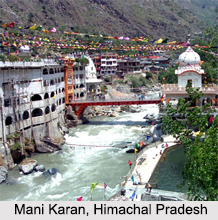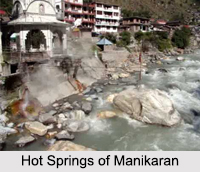 Located in the Kullu district on the Parvati valley between the Beas and Parvati River in Himachal Pradesh, Manikaran lies at an altitude of 1760 metre. Manikaran is famous for its hot springs, its numerous temples, Gurudwara and a beautiful landscape. The springs of Manikaran are reputed for their healing properties and are a balm for arthritis. Here the icy cold water of the Parvati River co-exists with the boiling water side by side.
Located in the Kullu district on the Parvati valley between the Beas and Parvati River in Himachal Pradesh, Manikaran lies at an altitude of 1760 metre. Manikaran is famous for its hot springs, its numerous temples, Gurudwara and a beautiful landscape. The springs of Manikaran are reputed for their healing properties and are a balm for arthritis. Here the icy cold water of the Parvati River co-exists with the boiling water side by side.
Legends of Manikaran
The term Manikaran means jewel of the ear. According to the Hindu legend, once Goddess Parvati lost one of her earrings while walking in the valley with Lord Shiva. The jewel was seized by Sheshnaag, the serpent king, who then disappeared into the earth with it. Lord Shiva sent his army to retrieve the lost jewel but when they failed it angered Shiva and he performed the cosmic dance- the Tandava, evoking the destructive forces of nature. The serpent king brought back the gemstone to pacify Lord Shiva. In another version of the legend, Sheshnaag was forced to spew hot water which still exists in the form of the geothermal springs and with that the jewel that Parvati lost was retrieved. Jewels began to surface in the waters at Manikaran until the Kangra earthquake of 1905.
 The Sikh legend is different from the Hindus, once Guru Nanak came to this place with his disciple Bhai Mardana. There was no food and Mardana was starving, Guru Nanak asked him to set up a Langar- a community kitchen. People donated flour and bread but there was no fire to cook it. Nanak asked him to lift up a stone from where a hot spring came up, there he put the rolled chapattis but to his dismay the chapattis sank. Nanak told him to pray to God for the sunken chapattis to come up baked. Mardana"s prayers were answered thus making the place pious for Sikh people. Guru Nanak said that people who donate in the name of God, their drowned items float back.
The Sikh legend is different from the Hindus, once Guru Nanak came to this place with his disciple Bhai Mardana. There was no food and Mardana was starving, Guru Nanak asked him to set up a Langar- a community kitchen. People donated flour and bread but there was no fire to cook it. Nanak asked him to lift up a stone from where a hot spring came up, there he put the rolled chapattis but to his dismay the chapattis sank. Nanak told him to pray to God for the sunken chapattis to come up baked. Mardana"s prayers were answered thus making the place pious for Sikh people. Guru Nanak said that people who donate in the name of God, their drowned items float back.
Religious Spots of Manikaran
Manikaran has temples of Hindu deities like Lord Rama, Krishna and Vishnu. The Ram Chandra Temple located 35 km from Kullu was built in the 17th century by Raja Jagat Singh. Legend says that Lord Rama brought this temple from Ayodhya and installed it here. The beautifully sculpted idols of the divine couple Rama and Sita catches the fantasy of the devotees. Then there is the Lord Shiva Temple, whose presiding deities are Lord Shiva and Parvati. The earthquake in 1905 caused damage to the temple and it became slightly tilted. Devotees throng to this temple to pay homage to the fierce Neelkantha. Another popular Hindu tourist spot is the Kulant Pith at Vishnu Kund, which is the holiest of all in Manikaran. The holy water of the Kund purges the soul of the devotees of anger and evil.
The most popular Sikh pilgrimage site in Manikaran is the Shri Guru Nanak Devji Gurudwara. This is the place where Guru Nanak had given sermons and people from all faith and religion visits here to feel a sense of spirituality and connection with the almighty.
The Bhuntar Airport is the closest one which brings pilgrims to Kullu by flight and the nearest railway station is at Chandigarh from where transportation is available till Kullu and also Manikaran.



















